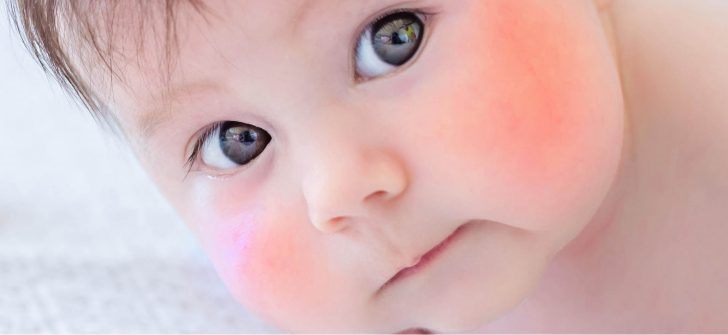Fifth disease is a viral infection affecting babies, young children and sometimes even adults. It is due to an infection with parvovirus B19. Characteristic signs of a fifth disease include body rash, face redness and even cold-like symptoms. Luckily, these symptoms are usually mild and tend to resolve on their own.

What Are the Symptoms of Fifth Disease in Babies?
If your baby gets infected with parvovirus B19, you will notice the following signs:
- Slight fever
- A sore throat
- A runny nose
- Headache
- Fatigue
- An upset stomach
- Diarrhea
- Eye redness
- Swollen glands, etc.
This signs and symptoms last for about 7 days before the skin rash becomes noticeable. The baby cheeks will become red, while this skin redness can also appear on other body parts such as in the hands or feet, trunk, buttocks, thighs, etc. Sometimes this skin rash is accompanied by itchiness as well. Rarely, blisters or bruises can be noticed.
In general, the skin rash tends to resolve within a week or up to 10 days. However, sometimes the skin rash can last up to one month or tend to reappear as your baby has a fever or if your baby is very active or upset.
In about 20% of fifth disease in babies, no signs and symptoms will be noticed. Among adults, joint pain is common when infected with parvovirus B19, while this symptom is not noticed in babies and young children.
When to See the Doctor
You should seek medical help in cases when the symptoms tend to get worse over the time. or when you notice a joint swelling in your baby.
In cases when the high fever lasts longer than normal, or if the fever becomes higher than 103.5 degrees Fahrenheit, you need to take your child to a doctor. It does not have to be an infection with parvovirus B19. This condition can be caused by other infections as well, which might require a different treatment.
Also, seek immediate medical help in cases when your child has other medical diseases such as cancer, leukemia, HIV infection or has had an organ transplant, as the fifth disease can be quite serious in these cases, causing even life-threatening complications.
Is Your Baby's Fifth Disease Contagious?
Yes, the fifth disease is contagious just like any other viral infections. It spreads from one person to the other with nasal secretion and saliva.
Once exposed to the virus, it will take about 14 days for the symptoms to become noticeable. During this period of incubation, your baby can transmit the viral infection to others. Fifth disease in babies is also contagious during the first week when cold-like symptoms become noticeable until the skin rash appears. By the time skin rash appears, the baby can no longer transmit the disease to others.
If your baby goes to daycare, you should keep him/her at home during the cold-like flu symptoms or during the incubation period.
How Is Fifth Disease Treated and Prevented?
Just like any viral infection, fifth disease infection requires supportive treatment which is characterized by bed rest and a lot of fluids. Acetaminophen or ibuprofen might be needed for the fever and discomfort. Do not give your baby aspirin, as it can result in Reye’s syndrome, a life-threatening medical condition.
Once the skin rash appears, your baby will be feeling much better. Sometimes, skin rash can be accompanied by itchiness, so a hydrocortisone topical cream or antihistamine topical cream might be necessary.
Sometimes, the fifth disease in babies can lead to anemia. In severe cases of anemia, hospitalization and even a blood transfusion are required.
How to Prevent Fifth Disease
Fifth disease viral infection has no vaccine which would prevent it. Because a person can transmit the viral infection before the skin rash becomes noticeable, it is kind of hard to prevent such an infection. However, you should not take your baby to daycare if you know that other children are being diagnosed with the fifth disease.
Teach your baby to wash the hands carefully, not to keep the fingers in the nose, mouth or eyes and to sneeze or cough using their elbows to cover the mouth.
